Rachel Neumeier's Blog, page 77
March 29, 2023
Life continues

Semi-emergency section today, two boys, two girls, all a good size.
I doubt these puppies will be as easy as Morgan’s Giant Boys, but they look good.
Please Feel Free to Share:






The post Life continues appeared first on Rachel Neumeier.
Update on Menewood
So, as you may recall, Menewood, the sequel to Hild, is due out in early October this year.
Here’s a cover reveal post at tor.com. I do like this cover. Better than the one for Hild, I think.
Do you recall who Hild was? Here:
Hild, today remembered as St Hilda, was born in 614, in Anglo-Saxon England, after her mother had a dream about her unborn child being a jewel that brings light to the land. She was the niece of King Edwin. She was baptized in 627, she left England for Gaul in 647, she was recruited to the church by Bishop Aidan, and she became a powerful advisor to kings and a teacher of five bishops.
Hild was, as you may also recall, one of my favorite-ever historicals and quite possibly my favorite novel of 2015. Wow, 2015! Always a surprise to see how much time has passed. Anyway, this first book took Hild from childhood up to young adulthood.’
Menewood picks up where Hild left off:
Hild is no longer the bright child who made a place in Edwin Overking’s court with her seemingly supernatural insight. She is eighteen, honed and tested, the formidable Lady of Elmet, now building her personal stronghold in the valley of Menewood. … Hild … must find a new strength, the implacable determination to forge a radically different path for herself and her people. In the valley, her last redoubt, her community slowly takes root. She trains herself and her unexpected allies in new ways of thinking as she prepares for one last wager: risking all on a single throw for a better future…
I can’t recall how many years this second book will encompass. Definitely not that many years of Hild’s life; Nicola Griffith has said that much.
I know Nicola had a lot going on in the past few years, but I will selfishly hope she completes the third book in less time. However, I’m definitely looking forward to this one regardless, and I guess I had better plan on re-reading Hild before October. It’s a book to read slowly and savor, so this won’t be a hardship.
If you haven’t read Hild … I guess I would say … if you loved Dorothy Dunnett’s Lymond series, maybe you should try Hild. It’s very different, but similarly immersive.
Please Feel Free to Share:






The post Update on Menewood appeared first on Rachel Neumeier.
March 28, 2023
New Books Out this April
Goodreads sent me one of its periodic emails this morning, and a couple books caught my eye, not exactly in a good way. (Goodreads is not that great at predicting what I might be interested in, but to be fair, I’ve really fallen down on the job of posting reviews to Goodreads for, goodness, the past two years at least, maybe more.)
Look at this, in the Fiction category:
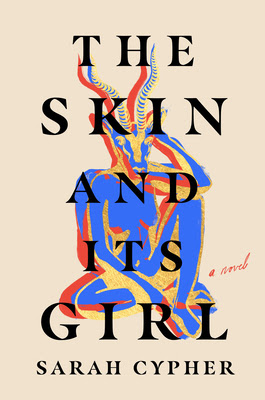
What do you think? I think the title is hard to read and, bonus, repulsive. The image isn’t that easy to make out either. As a side question, can the author’s name truly be “Cypher?” Here is the entry on Goodreads. In a Pacific Northwest hospital far from the Rummani family’s ancestral home in Palestine, the heart of a stillborn baby begins to beat and her skin turns a vibrant, permanent cobalt blue. Sounds like magical realism in at least this respect.
How about this one? It’s horror.
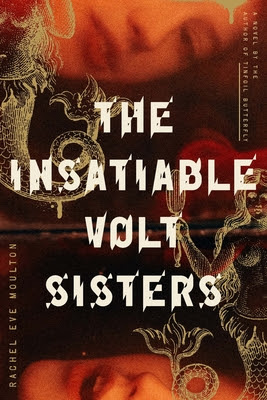
The title is almost as hard to read and turns me off almost as much, in a completely different way. Told from the perspectives of four flawed, fascinating women, The Insatiable Volt Sisters is a lush, enthralling fable about monsters real and imagined and the sometimes painful bonds of sisterhood. I’m not much for horror as a rule and I don’t think this sounds like my cup of tea. Also, I hate the word “insatiable” here. However, here’s a Goodreads review that makes this book sound a lot more inviting: Jumping into books blindly is such an adventure. I was expecting a book about two sisters on a mysterious island, and I ended up with a book about two sisters, a mysterious island, and honest to God monsters. Fantasy and horror elements aren’t usually my jam, but hats off to the writer for creating a twisted, imaginative modern-day fable. Honest to God monsters, really? That sounds much better.
Next, memoir:

And here is where I said to myself, seriously? SERIOUSLY? Who thought scribbling over the title was a good idea?
Anyway, here: As a self-described “not white, mostly Black, and questionably Asian man,” Chin-Quee knows that he doesn’t fit easily into any category. Growing up in a family with a background of depression, he struggled with relationships, feelings of inadequacy, and a fear of failure that made it difficult for him to forge lasting bonds with others.
I seldom like memoir and nothing about this appeals to me. But here’s the Goodreads page if you’d like to check it out.
Not much catches my eye in a good way in this particular mailing, but I do like this, in nonfiction:
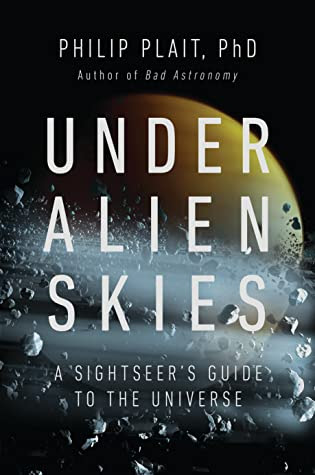
How would Saturn’s rings look from a spaceship sailing just above them? If you were falling into a black hole, what’s the last thing you’d see before your spaghettification? What would it be like to visit the faraway places we currently experience only through high-powered telescopes and robotic emissaries? Faster-than-light travel may never be invented, but we can still take the scenic route through the universe with renowned astronomer and science communicator Philip Plait.
On this lively, immersive adventure through the cosmos, Plait draws ingeniously on the latest scientific research to transport readers to ten spectacular sites, from our own familiar Moon to the outer reaches of our solar system and far beyond. Whether strolling through a dust storm under Mars’ butterscotch sky, witnessing the birth of a star, or getting dizzy in a technicolor nebula, Plait is an illuminating, entertaining guide to the most otherworldly views in our universe.
Please Feel Free to Share:






The post New Books Out this April appeared first on Rachel Neumeier.
March 27, 2023
In the Midst of Life
Ch Roycroft Keya Cameron RN C-RA
Keya as a slim puppy

Keya was very difficult to show. She didn’t like showing. I didn’t get her till she was six months old, and poor socialization as a puppy meant she really didn’t like strangers reaching toward her. Pretty as she was, she had a hard time picking up points. For a couple years, my whole job when showing her was to assure her that showing was fun and that judges could be ignored. I learned a lot from her: mostly how to teach a dog to stand solidly and not worry. I showed her in performance and that was a challenge in a different way, but she was SO food motivated, so that wasn’t bad.
Not actually hiding; she’s staring at me, hoping for a cookie.

Keya matured into a really pretty girl. A white sclera in one eye, which is not desirable in a show dog, but pretty despite that. She was very (very) low-drive, with no prey drive at all. I used to bring her along whenever I took dogs to the park or hiking because Keya didn’t need to be on leash. She didn’t care about squirrels and would look at a deer or horse with complete disinterest. Once, a rabbit ran across the trail right in front of me. The other dogs with me barked madly and pulled hard, wanting to chase the bunny. Keya went to the brush where the rabbit had disappeared, poked her head into the undergrowth, backed out, and looked at me. “Are you coming?” she asked, as clearly as if she’d spoken aloud. “Oh, you’re not coming? Never mind then.” And that was it. She sure wasn’t going to bother chasing a bunny without me.
What Keya loved most in life was sitting on a couch eating treats, and being near me. She honestly didn’t care about anything or anyone else. She was fine with strangers, but disinterested. Unless they had treats, of course, but I didn’t encourage other people to offer her treats. She would snap for a cookie with a little too much verve. You had to be quick to avoid nipped fingers.

I kept showing her, and eventually we both learned how to show properly: Keya learned to stand like a rock and wag her tail, and I learned to hand out chicken tidbits continuously, without a break, and boom, she finished her championship. She was five. That’s pretty old to finish. But we did it, just about the same time one of her two daughters (Honey) also finished. I was entering them both in the same shows by that time. Keya was prettier but her daughter Honey had the most fantastic movement, so it depended on the judge, but they both picked up points.
Standing like a rock

I bred Keya four times, but she was a terrible, terrible producer. Words can hardly describe how terrible. She had four litters, from which I got a total of three living puppies. Most of her puppies kept dying about two days before the due date. This was devastating because her father was so, so fantastic. His name was AKC and CKCSC Sanickro Enchanter at Heartsong, and he lived to eighteen and never had a heart murmur. He was the top-pointed Cavalier in 1999, a stunning dog, and by sixteen clearly just about the best dog in the country for heart quality and overall vigor. That’s exactly what I wanted, of course.
I had two puppies from him, half sisters. The other is a year younger than Keya and to this day has no heart murmur at all, but I placed her as a pet long before anyone could tell she’d never develop a murmur. Keya was prettier, so she was the one I kept to go on with. Keya developed a murmur at, I don’t remember, seven or eight, and her heart gradually enlarged, but she never had any symptoms of congestive heart failure. Eventually the cardiologist told me to start counting her respirations while resting and call for a consult when her respirations went over thirty per minute. For the next three years, I counted resting respirations once a week. Twenty to twenty-four the whole time. It wasn’t her heart that took her from me.
Keya’s two daughters, like their mother, were bad producers, with lots of trouble with premature labor. I figured that out eventually and started taking many complicated steps to get them to carry a full litter to term. Even so, I nearly quit breeding. It was so difficult and heartbreaking and also expensive. Then Ish turned out to be so, so beautiful. I un-quit after a year or so and went on after all.
Ismael, Keya’s oldest grandpuppy, now nine and heart-clear

***
Kimmie, Keya’s second grandpuppy, and Morgan, Kim’s single puppy, Keya’s great-grandpuppy

***
Morgan

***
Conner, Kimmie’s full brother, here about four months old, looking exactly like a stuffed animal. He’s six or seven now.

***
Kimmie, playing with Morgan’s first litter, Keya’s great-great-grandpuppies

***
Naamah, another of Keya’s great-grandpuppies, Conner’s only daughter, playing with her cousin’s Morgan’s puppies

***
Keya, much, much older, but still beautiful

Around a year and a half ago, Keya suddenly had a seizure. Then she had another. And another, and another, and one more before my vet and I got them stopped. Her timing was one every three hours or so, with a long post-ictal period of about an hour and a half.
We all know what seizures mean in a geriatric dog. That means a brain tumor, almost all the time. I didn’t do an MRI to confirm because there was zero chance I’d put her through brain surgery. Cavaliers tend not to die of cancer and particularly tend not to die young of cancer. Some can do fine for a long time. And for a while, Keya did do fine. She was on phenobarb, but it barely affected her while turning off the seizures.
The she started having breakthrough seizures. They weren’t as bad. The post-ictal period was almost completely absent. Still, my vet and I did our best to stop them and finally put her on Levetiracetam as well as phenobarb, and all was fine. For a while. Then breakthrough again, and Clorazipate joined the mix. That one knocked her way, way down, having a far more deleterious effect on her life than occasional seizures, so that made all kinds of decisions more difficult. And so we went on from there, backing off the Clorazipate and then putting her back on it, but at a lower dose, and so forth and so on. Keya’s balance got worse and worse. She started having trouble on tile and I got a bunch of long carpet runners to help her get around the house better. That worked for some time.
This past couple of weeks, Keya started having frequent minor seizures where she would zone out for a couple of minutes, then recover.
Last week, she began having extended periods every day where she couldn’t get up on tile, but also had trouble standing and walking on carpet. She would be more able to stand and walk sometimes, but a lot of the time she would struggle for minute after minute and still not be able to stand. Helped to her feet, she might manage, or she might totter a couple of steps and then sink back down. She hasn’t been in pain, as far as I can tell. Not at any point. She’s continued to love food. But I finally decided her impaired mobility and the more obvious progression of seizure activity meant it was time.
Last night, I asked my vet to work her in. She was almost exactly fourteen years and four months. I can’t believe how long it’s been, or how short a time it seems.
Please Feel Free to Share:






The post In the Midst of Life appeared first on Rachel Neumeier.
Monday Update: Tedious proofreading is tedious, plus puppies
A) So, having totally marked up a paper copy of NO FOREIGN SKY, with many notes to myself as well as just proofreading corrections, I am now going through and integrating all that into the digital file. Wow, is this boring. It’s so, so boring.
Well, except for the bits where I run into a more substantive comment and then I have to turn my brain to the “on” position and think about whether to tweak the text and if so, how. That is a whole lot less tedious, but more difficult and time consuming. I cherish every page where I didn’t make any corrections or notes.
This is not a part of the process I enjoy — you may have guessed that — and it’s a lot more difficult for this particular book because I’ve gone over it SO OFTEN that my eyes start to glaze over whenever I open the file. Therefore, I’ve been doing it a little at a time. However, I’m closing in on it now and hope to have it finished by the end of today, or more likely the end of tomorrow, barring major interruptions of whatever sort.
That will allow me to move on to straight-up proofreading for actual typos. I’m not finding many typos myself in this read-through, but I’m concentrating on other things; I’m sure there are plenty I’m missing. Many proofing passes, by me and others, coming up. Probably all through April.
Meanwhile:
B) My mother has finished proofing TASMAKAT. As soon as I send off NO FOREIGN SKY to proofreaders, it’ll be my turn to proofread TASMAKAT. That will be less tedious, I hope, because I shouldn’t be making as many substantive comments on that one. However, no doubt there will be a good many less substantive comments and since the book is so long, I expect that will reach new heights, or troughs, of tedium in that regard.
My mother is doing really, really well, by the way. I seriously hope I do this well if I ever need significant surgery of any kind. Her staples come out at the end of this week and then she will, I think, be free of all remaining dietary restrictions. She isn’t eating nearly enough. I look forward to making her doughnuts to celebrate.
Also meanwhile:
C) Puppies!
I was trying to think of the last time I had such easy puppies and I think I know. I think that was Litter E, Bree’s puppies, Ellie, Eve, and Merlin, later called Jack. Those puppies were enormous at birth, gained weight right away, and were huge as youngsters. Eve came out a perfectly average size, Ellie wound up on the big side, and Jack is one of the two puppies I have ever produced that I have completely lost track of. That does bother me. Quite a bit, in fact. I will never know whether the people dropped out of touch because they moved away and/or didn’t believe I would care, or because they carelessly let my puppy get hit by a car and didn’t want to tell me, or what. I’m much happier when pet people keep in touch.
Anyway, the E litter is now fourteen years old, I believe. During those fourteen years, I don’t think I’ve ever had another really easy litter, until now. This is my Q litter. What is that, twelve litters? Thirteen, because all the puppies died in the first F litter (Yes, that was heartbreaking.) and I later repeated the letter. Since this is Q and they’re both boys, I expect I may name one Don Quixote and the other something like Quintessential.
Blen boy is a fine, normal, easy puppy who is gaining about an ounce per day.
Tricolor Boy is a total pig and is gaining OVER TWO OUNCES A DAY. He is going to be one of the fat puppies who is slow to get up on his feet, I expect. He is a pound and a half! About seventy grams above his brother at the moment.

Size at this age is meaningless, by the way. After weaning, the ones who were not nursing as well or were small for other unimportant reasons will catch up, while the super fat puppies will run off the excess weight, and they all wind up whatever weight they’re genetically predestined to be.
Anyway, while I’m supervising rather casually and asking my mother to supervise them when I’m not home — which I am astounded she is in shape to do, but she is — casual is indeed the term. They’re too big and fat to easily get chilled. Morgan can’t possibly squish a baby as big as these. They’re both nursing fine. Therefore I’ve been able to ask my mother to just ignore them. She’s there only in case she hears distress cheeping that might signal some weird problem.
Weird problems: things like the time my Honey jumped to her feet and threw her puppy, Kimmie, who had climbed up on her, out of the whelping box onto the tile. THAT will chill a puppy in a hurry, even a big puppy, and that is why I strongly prefer someone to be there.
Anyway, while things can go wrong — a strong puppy sometimes stalls out for no obvious reason and must be tube-fed to rev him back up — I am not sitting around worrying about these puppies.
No, I’m sitting around worrying about LEDA’S puppies. She is a tank. She looks like she’s going to explode. I don’t think she’ll make it to Friday. I think there may be so many puppies that labor would be seriously problematic — litter too large is one among (many) reasons a bitch may not be able to deliver normally. I may call up to the reproductive clinic and ask for an emergency section on Wednesday, which is about as early as I think is reasonable.
It’s a good thing I have tedious proofreading to keep me busy, because I don’t think I’m going to be capable of much else this week.
Please Feel Free to Share:






The post Monday Update: Tedious proofreading is tedious, plus puppies appeared first on Rachel Neumeier.
March 24, 2023
Lots of promising titles are just pinging my radar
For some reason, I’m suddenly noticing a lot of titles that are due out this year, or sometimes have been out for a little while.
I mean, this just appeared on one of Amazon’s “Maybe you’d be interested” lists:
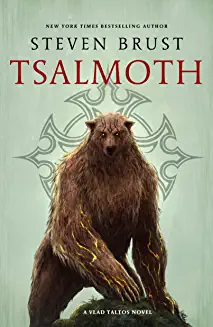
Why, yes, I would indeed be interested.
Is that how you visualized a tsalmoth? (DID you visualize a tsalmoth?)
Although I would have said I have never particularly visualized a tsalmoth, I didn’t expect it to be so very bear-like. Also, I sort of think the proportions are funny. Doesn’t the head look really small compared to that front leg?
What is the line for tsalmoths? It’s “Tsalmoth maintains though none knows how,” and I’m astonished I remembered that, but it came right up to the top of my memory when I tried to call it to mind. Maybe the creature is supposed to be kind of a ground sloth! That would be neat! There’s no particular reason to think ground sloths were a lot slower than bears, but I can see how the word “sloth” might make someone think slow and lead to that kind of line.
All right, so do we recall where Vlad was at the end of the previous book? Though you never know, Brust might decide to do another prequel. I would rather move forward. Let’s see what the description says:
First comes love. Then comes marriage…
Vlad Taltos is in love. With a former assassin who may just be better than he is at the Game. Women like this don’t come along every day and no way is he passing up a sure bet. So a wedding is being planned. Along with a shady deal gone wrong and a dead man who owes Vlad money. Setting up the first and trying to deal with the second is bad enough. And then bigger powers decide that Vlad is the perfect patsy to shake the power structure of the kingdom. More’s the pity that his soul is sent walkabout to do it.
How might Vlad get his soul back and have any shot at a happy ending? Well, there’s the tale…
Oh, that certainly sounds like a prequel! Worse, a prequel centered around Cawti, whom I do not care for because of the way her story played out and most particularly because Tecka was surely the worst book Brust has ever written and one of the worst series installments in any long-running series by anyone ever. Not that I feel strongly about this or anything.
Tsalmoth is out as a preorder, due to drop this April, and therefore there are no reviews at Amazon. Let me poke at google … yes, there are a few reviews at Goodreads. Yes, definitely a prequel, set a bit after Yendi and before Jhereg. Of course those were the first two books published and also arguably the best and ALSO a very good place to start, so if I were advising someone new to the series, I would probably suggest:
Forget publication order. Read the books in this order: Taltos, Yendi, Dragon, Tsalmoth, Jhereg and stop. The links go to collections that contain these books, among others. Library Thing has a list in chronological order.
OR if not going in strict internal chronological order, then maybe this order: Jhereg, Taltos, Yendi, Dragon, Tsalmoth, and re-read Jhereg. That’s because Jhereg is a really good starting point plus would probably be fun to re-read after getting back to that point in time. But the above is chronological order within the story world and also a good order in which to read the books. AND the next book along is Tekla and I would strongly advice readers to SKIP TECKLA and NEVER READ IT, that’s how bad a taste it left in my mouth. Yes, events there are referenced later, but so what, leave those events in backstory and assume Cawti broke up with Vlad because she went moderately nutty and move on.
Meanwhile, look at this: Barbara Hambly has been writing stuff and I have missed it until now. I think again something new of hers popped up as an Amazon suggestion, and their algorithms are doing pretty well, because sure, tell me about these books, by all means!
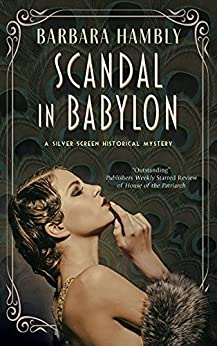
Scandal in Babylon, first of a historical duology, the second of which comes out next week. This looks VERY MUCH like a historical mystery that is actually a version of Bride of the Rat God I mean, look:
1924. After six months in Hollywood, young British widow Emma Blackstone has come to love her new employer, glamourous movie-star Kitty Flint – even if her late husband’s sister is one of the worst actresses she’s ever seen. Looking after Kitty and her three adorable Pekinese dogs isn’t work Emma dreamed of, but Kitty rescued her when she was all alone in the world. Now, the worst thing academically-minded Emma has to worry about is the shocking historical inaccuracies of the films Kitty stars in. Until, that is, Rex Festraw – Kitty’s first husband, to whom she may or may not still be married – turns up dead in her dressing room, a threatening letter seemingly from Kitty in his pocket. Emma’s certain her flighty but kind-hearted sister-in-law has been framed. But who by? And why? From spiteful rivals to jealous boyfriends, the suspects are numerous. But as Emma investigates, she begins to untangle a deadly plot – and there’s something Kitty’s not telling her . . .
That set up is VERY similar to Bride of the Rat God, which is, by the way, an excellent historical fantasy novel. The ridiculous title draws heavily on the ridiculous titles of B-grade horror movies of the era, that’s the whole point, but probably that title did not help sales. But, I mean, compare the above description to this:
It is 1923, and silent film reigns in Hollywood. Of all the starlets, none is more beloved than Chrysanda Flamande, a diva as brilliant as she is difficult to manage. Handling her falls to Norah, widow of Chrysanda’s dead brother. She has always done her job well, but she was never equipped to deal with murder. When a violent killing shocks Chrysanda’s entourage, and other weird happenings swiftly follow, Norah begins to suspect that some strange power is stalking the star. …
And although this doesn’t mention the three Pekingese, they are very much here, and excellent little dogs they are, too. Plus Crysandra is not brilliant. She’s a terrible actress, though a very nice person, so it sounds like she’s a LOT like Kitty. I’m wondering now whether Hambly felt compelled to write a fantasy because that’s the genre she was already writing, and so tilted a historical into the realm of fantasy, but maybe she always felt like she would prefer it as a straight historical mystery. That’s possible. That would be a bit like Marta Randall, turning Sword of Winter into Mapping Winter. The original was good, the revised version was better, and I’m sorry to note that there’s no third book yet listed for Mapping Winter. I would certainly be interested in that. Perhaps Amazon will show it to me if that ever gets written.
Anyway, in general I think Barbara Hambly writes really good historicals, whether they’re straight up mysteries like the ones featuring Abigail Adams and published under the name “Barbara Hamilton” or suspense/mysteries like the Benjamin January series or the vampire historicals. She’s a fine writer. I’m definitely interested.
But that’s not all. Because check this out: a new fantasy novel that just dropped a week ago.
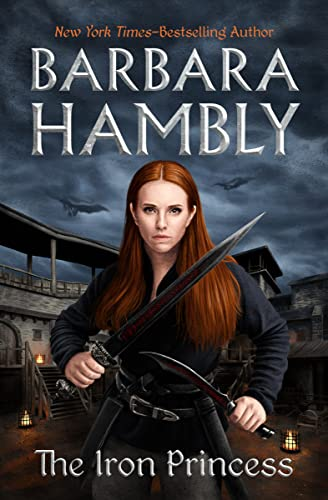
I did not see that coming. I thought she was done with straight fantasy.
Clea’s only hope to save her people is a wizard who retains his power, one who will not betray her, either to the great merchant houses or to the all-entangling web of the Crystal Mages. But that wizard—Ithrazel the Cursed, destroyer of a city and magically imprisoned to suffer undying, unremitting torment—wants nothing to do with saving the world, helping a hero, or unraveling the terrible secret at the heart of the Crystal Mages’ plans.
This looks unconnected to any other fantasy world of hers. I wonder if this is an older book which she recently decided to bring out.
Coming up is something else interesting: Translation State by Ann Leckie, and if you immediately thought of the Presger translators, yes.
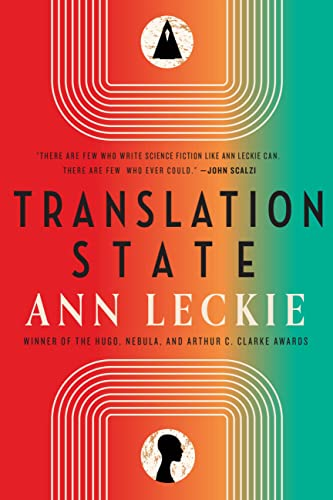
Qven was created to be a Presger translator. The pride of their Clade, they always had a clear path before them: learn human ways, and eventually, make a match and serve as an intermediary between the dangerous alien Presger and the human worlds. The realization that they might want something else isn’t “optimal behavior”. It’s the type of behavior that results in elimination.
The Presger translators were a tremendously cool feature of the Ancillary Justice trilogy. This book is dropping in June. I’m certainly interested, though not enough to preorder it for $15 when I have 400 other titles on my virtual TBR pile already. Even so, very interesting and I look forward to hearing what people think of it.
Then, Later in the year, guess what’s out? Defiance, the 22nd Foreigner book is dropping this fall.
There’s no cover yet, alas. Still, that’s good to see.
Though I hope I enjoy this book, I would like to see CJC end this particular storyline and move on in the world. I stand by my suggestion that she tie the current series up with a nice bow, step forward in time, have the Dowager have died of extreme old age, have Bren as a mentor rather than a pov character, and allow the children, particularly Cajeiri and Irene, step up and take center stage. I admittedly feel that way partly because I was, as you may recall, unimpressed by the 20th book in the series and the 21st book, though better, could not, for me, rescue the extreme plotting discontinuity between the 19th and 20th books. Therefore, I would prefer to see CJC go 20-21-22, tie up this internal trilogy, and MOVE ON.
I should add, not like I would refuse to continue the series if she doesn’t do it that way. Unless she has another hard-fail in continuity, and then I might finally and very reluctantly quit, even though this is my favorite long SF series by a lot. I could give away the last three books and treat this as a 19-book series.
However, I hope she continues this world in some way that I appreciate.
You know, I suddenly realized, I could not possibly make that kind of dire continuity mistake. You all would never let that happen. I don’t think I would do that anyway — I do re-read series novels as I continue the series — but it’s actually good to know you would not let me get away with that.
Please Feel Free to Share:






The post Lots of promising titles are just pinging my radar appeared first on Rachel Neumeier.
March 22, 2023
The Pain of Punctuation
At Writer Unboxed, a perennially engaging topic: Assuaging the Pain of Punctuation
Punctuation can be as thrilling as grammar: The wrongly maligned semicolon magicking a comma-spliced run-on sentence into an elegant complex thought; the jocular, informal em dash heralding an impending related tangent, explanation, elaboration, or contradiction that reflects so well the way many of us think and talk.
We’re off to a good start, as I certainly like both semicolons and dashes.
Let’s start with the most egregious punctuation violation: If you are still using two spaces after a period, I invite you to stop it. That convention is a relic of the earliest days of typography, and using it may make you look like a dinosaur. Of course, you are welcome to continue insisting upon it, but let’s acknowledge that it’s a bit of an affectation, like wearing a monocle, isn’t it? …
And here’s the skinny on ellipses: No more does the venerated world of publishing add a persnickety little space between each dot. Close those puppies right on up…just like that…
Oh, and I have comments regarding both these tidbits of advice!
Sure, you can quit using two spaces after a period, but you know what else you can do? Type with two spaces and then uses find and replace to magically turn them all into single spaces. EVEN IF you type with one space, I suggest you do a find and replace at the end as part of your final formatting job, because there are always some instances where you have two spaces and didn’t realize that. I do three rounds of find and replace to be sure I get them all. Otherwise the occasional triple or quadruple space does not get corrected.
I did change from two spaces to one, but ONLY when I hurt my right thumb badly enough that I quit using it at all when typing. If you’re re-training yourself to use your left thumb on the space bar, that is an excellent time to also train yourself to only hit the space bar once. But it’s absolutely no trouble to change two spaces to one, so there is no need to bother re-training your typing habit if you don’t feel like it.
Also, the best way to do ellipses is space … space, and the reason for that is twofold.
First, if you open them up space . space . space . space, then when right-and-left justified, the spaces between the dots is going to get stretched out weirdly and that is going to happen not just occasionally, but all the time. Also, when the text is re-sized in ereaders, you are certain to wind up with two dots on one line and the other dot on the next line, and that looks stupid. Keeping the three dots together will prevent both of those problems.
Second, if you close them all the way up with no spaces on either side of the ellipse, then longword…longword is going to screw up the spacing of words and lines in the ebook when the font is re-sized. His tendency toward, what is the right term…sesquipedalianism…could be somewhat exasperating, she thought. Look at that. With no spaces, term…sesquipedalianism…could is going to be forced onto one line in many ereaders and that is going to look just terrible. Spaces on both sides of the … prevent that from happening.
That is also why I really, honestly prefer dashes with spaces, and to avoid them being so long, en-dashes with spaces. But that is never done, so I resignedly use em-dashes with no spaces even though this also screws up word and line spacing on ereaders. But for ellipese, there’s no set-in-stone standard and you can get away with different choices, so space … space is allowed and that is what looks best, and I am not going to change my mind about that.
Let me see, what else do we have in this post … oh, a lot about quote marks. Yes, well, sometimes the thing to do is not type this:
“But can I believe him when he says, ‘I didn’t do it’?”
but rephrase to avoid the question of (a) whether the question mark goes inside or outside which quote marks, and (b) whether that will look wrong to readers even if it is correct. If it’s even plausible that your weird quote marks might look wrong to a significant number of readers, just write:
“But can I believe him when he says he didn’t do it?”
and poof, no problem.
My main pet peeve with punctuation is none of the above. My main problem is my phone’s autocorrect function choosing whether to include or exclude apostrophes at random, especially if I’m not wearing reading glasses and may therefore miss the switch of the correct “its” for the wrong “it’s.”
Please Feel Free to Share:






The post The Pain of Punctuation appeared first on Rachel Neumeier.
March 20, 2023
Story structure
Interesting post at Write to Done: The Art of Story Structure
Keeping in mind that there are multiple methods that authors use to structure and outline their stories, we’ll focus on some of the main aspects that remain the same throughout each technique…
These are, briefly: the opener, the catalyst, growing tension, the climax, the end.
The catalyst is the same thing as the inciting incident, and that can be part of the opening, of course, as mentioned in recent posts here. I think I do prefer the term “catalyst” now that I think about it. “Incite” has a connotation of tension and anger, while “catalyst” just means the thing that causes movement, that starts the story moving, that begins a change. I’ll try to remember to use the term “catalyst” from now on.
Anyway, practically everything longer than a short story is going to have the catalyst, but then repeats that go from growing tension –> problem/resolution over and over. Four times, five, six, it depends on the length of the story, but multiple iterations for anything nonvel-length.
As a rule, when those iterations are occurring, each problem is likely to be more serious or emotionally intense than the last until the climax finally occurs.
One way to get a low-tension novel is to have the repeated problems all be low-stress; that’s probably a slice-of-life story. Nathan Lowell’s Quarter Share is an example. Another is to have each problem resolve before the next problem appears; that can produce a comfortable, engaging story for the reader who isn’t into high-tension and extreme-crisis stories, at least not at the moment. That’s like The Book of Firsts by AKH or Six Ways to Write a Love Letter by Jackson Pierce, and though both of those are romances, I’m sure you get that kind of story in other genres.
Other stories really lean into ratcheting up the tension with a structure that goes problem –> worse problem –> worse again —> super terrible –> mega extreme crisis –> at last the climax. I think the Hunger Games trilogy fits this pattern, for example.
In between we get all sorts of novels that kind of go problem –> resolved –> different problem –> bigger problem –> whew, resolved –> different problem –> bigger problem –> crisis –> climax and resolution –> falling action –> final ending.
In other words, they’re doing different things at different times, with some problems that resolve right away and others that linger, with unexpected consequences and resolutions later. And I do think that the climax usually ends with a resolution that is important, but that the falling action of the denouement comes after that, so there’s the climactic resolution but that isn’t the same as the ending of the story. So it’s all complicated in the real world. Still, it’s interesting to think about structural patterns in novels.
The linked post details seven story structures. I think these are all supposed to be variations on the above theme. I’m not going to detail them all — you can click through if you like, but let’s look at a couple to get an idea of the variations offered in this post.
First: The Dean Koontz structure. The terms for the structural high points are entertaining. Here they are:
The sooner the trouble, the betterIt’s all downhill from hereUtter hopelessnessSuccess against all oddsThat seems about right! A lot of Koontz novels do follow that kind of pattern. The post says “success or failure against all odds,” but with Koontz himself, it’s always success. That’s why I like his novels much better than various other horror novels: because I depend on Dean Koontz to provide success and not kill the characters I like best. There’s an exception, in a sense, with the Odd Thomas series. But that ending still offers success and is not really tragic, despite the ultimate ending. I do think that Koontz isn’t always that great a writer, BUT this series shows some of his best work. Also, I like his dogs. There’s a ghost dog in this series.
I often, not always but frequently, do appreciate a story that starts right out of the gate without a lot of setup, so I like the idea of “the sooner the better” for the catalyst. I began a new-to-me fantasy last night and stopped after two pages, not for any fault in the story at all, but because I could see there was going to be an extended period of setup and I wasn’t in the mood. Maybe I’m in the mood to re-read something instead. That way I can relax and enjoy a slow unfolding of the story.
Anyway, there’s a lot to be said for a fast start. Though downhill all the way can be too high-tension for me at the moment. That’s where it can be good to be reading a familiar author whom you trust will eventually provide a non-tragic ending.
Okay, what’s the next story structure?
Second: In Media Res. Oh, that’s a completely different sort of fast start. This story structure goes:
Rising actionBackstoryClimaxDenouementResolutionAnd all I can say is, you better be (a) quick to get out of the backstory, or (b) a really good writer, because I am not that patient. I mean, at all. Maybe I used to be a more patient reader, but these days if you begin the story and then stop short on a cliffhanger and say, “You know, back when I was a child, my mother told me …” and begin an extended backstory segment, there’s a good chance I’m not going to follow along for that.
The greater problem with in media res is that starting off with unknown characters struggling against unfamiliar opponents in an unfamiliar setting is just asking a lot of the reader.
While on this topic, Crime Reads has a good post about worldbuilding when starting in media res.
All You Need is Kill by Hiroshi Sakurazaka, the basis for the movie Edge of Tomorrow, starts pretty much smack in the middle of an all-out firefight through the point of view of a soldier wearing power armor. It’s also a time loop story, which becomes apparent a little later on. We don’t even know until several pages in that the enemy is an alien invasion force. You’d think that’d be the hook, but no. The hook is the immersion.
And then there’s the first chapter of Hannu Rajaniemi’s The Quantum Thief, which starts with the absolutely killer opening line “As always, before the warmind and I shoot each other, I try to make small talk.” And just gets weirder from there.
What these examples all have in common is the utter confidence of the prose and the absolute surefootedness of the pacing. Both of these things, when done right, are worldbuilding—and they do it in less space than paragraphs of exposition. And yet it’s so hard to find. … As a reader, I hate being spoon-fed exposition. … I want to put in the work to understand. More, I want to feel it—whatever it is you’re saying—viscerally. … Most of all I want to be let into the story yesterday.
I would say that of course it’s hard to find books with that kind of opening because utter confidence with the prose and absolute surefootedness with the pacing is uncommon, plus a really skilled writer may not choose to start in media res. There are plenty of other ways to start. But at the moment at least, I also feel that I want to be let into the story at once, immediately, with as little set up as possible. Of course that’s not always how I feel. I loved the effective but veeeerrrrry slow opening of From All False Doctrine, for example. The catalyst there is the meeting of the four people on the beach and from there we have a leisurely opening that is not quite as meandering as it might appear.
I haven’t read the abovementioned novels, but I have to say, The Quantum Thief does indeed offer a killer opening line. Have any of you read it? What did you think?
Before moving on to think about other types of story structures, I think Susannah Clarke’s Piranesi might be an example of an in media res kind of opening. I’m not sure. But it leaped to mind for me. Here’s the beginning:
When the Moon rose in the Third Northern Hall I went to the Ninth Vestibule to witness the joining of three Tides. This is something that happens only once every eight years.
The Ninth Vestibule is remarkable for the three great Staircases it contains. Its walls are lined with marble statues, hundreds and hundreds of them, Tier upon Tier, rising into the distant heights.
And here we have a peculiar sort of in media res opening in the first two sentences, then a step back for worldbuilding in the next paragraph. I thought of this opening because it’s very definitely an example of utter confidence of the prose and absolute surefootedness of the pacing. I found this story immediately compelling, even though it’s so odd, because of the quality of the writing, the instant appeal of the protagonist, and the poetic setting.
Let me see, what other story structures are offered by the linked post … oh, a VERY EXTENDED Hero’s Journey structure, so detailed it’s practically an outline. Meet the Mentor, for example. That’s really too detailed, imo. Not every Hero’s Journey is going to include a mentor. Though possibly a lot do. I mean, I can think of some that definitely do fit this structure, mentor and all.
If I were looking around for a Hero’s Journey novel I’ve read recently, I might pick Sherwood Smith’s Phoenix Feather quadrilogy. That is a truly classic hero’s journey, but slow, especially at first; with multiple protagonists, multiple mentors along the way, a lot of tests, allies and enemies; a lot of ordeals to face and overcome; and then a return home, but as a different person, a better person; and with “home” redefined and also better than it started.
I should re-read this one from the top. Especially since it’s about as low-stress as a Hero’s Journey is likely to be, for many reasons, including how quickly the Big Bad Guys are defeated whenever they are actually encountered.
But moving on. What’s next?
Ah, the 7-Point Structure, much vaguer. Hook, plot turn, pinch point, midpoint, pinch point, plot point, resolution. The pinch points, it says here, “increase pressure on the protagonist.” I wondered, as I don’t recall hearing that term before.
Oh, the next after that isn’t a structure, it’s a method. You’ve heard of it, I’m sure: Write a one-sentence pitch, expand that into a synopsis, then write out detailed summaries of the character backstories — I’m recoiling pretty hard at this point. It goes on and on. For the writers who want to create a world bible and character sketches and a complete outline before writing the novel, sure. For me, no. Let me go on to the next story structure …
Oh, the very basic Three-Act structure. The Set-up, the Confrontation, the Resolution. I don’t know why you’d even bother. While the previous structure seemed way, way overdoing it, this seems practically as far on the other side of the spectrum.
Then the post ends with Bell’s “A Disturbance and Two Doorways,” which I don’t recall hearing about before, but that’s certainly evocative. This could just as easily be called The Catalyst and two Choices, each of which, once taken, can’t be unchosen.
Well, this is an interesting post, though I do think it is useful to think of actual novels that might be seen as fitting into each structure. Though the vaguest structure is going to be difficult to see when embedded in a real story, and the thing that wants you to create a world bible and all the rest of it definitely doesn’t count as a structure at all.
I’m curious: does TANO seem to be a high-tension story? To me, no. I would say TANO’s structure goes something like this:
Set up –> catalyst –> problem –> new problem –> crisis! –> action (what I think Bell might call a Doorway and I might call a choice to act) –> resolution –> new problem arising from the original problem –> worse problem –> choice to act and resolution –> second crisis! unresolved –> falling action –> problem –> problem from a different angle –> climax and resolution. And then the epilogue recasts the second crisis and resolves that.
To me, this is not a high tension type of structure because several problems are presented, but then are resolved long before the story reaches the climactic scene. Also because of the period of falling action after the unresolved crisis, which leads into a milder (if increasing) kind of tension and problem.
Also because Tano doubts himself probably much more than the reader doubts him.
And finally because the movement in the various relationships is always in a positive direction. To me, that always reduces tension, almost always in a good way. I don’t like reading about misunderstandings, especially not extended, serious misunderstandings. I prefer to see relationships move in a positive direction with only minor stutters. That’s how the relationships work here, not just among the young men, but the adults are much (much) less condemnatory than Tano expects. I think the reader is in a position to understand that better than Tano and that also reduces tension.
On the other hand, I knew a lot about all this and a reader may have a different perception! Did you perceive this as a lower-tension or higher-tension story when you read it?
Please Feel Free to Share:






The post Story structure appeared first on Rachel Neumeier.
Monday Update: Slow Progress and Big Events
All right, so, as you know, one week ago today, my mother had surgery. That went extremely well, she came home after four days — a day early — and was practically not restricted. Do not, quote, lift anything over twenty pounds, unquote. Well, shoot, I’m not crazy about heaving around anything over twenty pounds myself and I’m thirty years younger and haven’t just had surgery!
Anyway, she’s on a moderately restricted diet for another week, but is doing amazingly well.
Progress on other fronts:
a) I’ve got, right here, a paper copy of No Foreign Sky, which I am reading and correcting with a pencil. It makes a tremendous difference to have a paper copy. I honestly do not know why. All sorts of things jump out at me, not just typos, but repeated words, phrases I might want to revise, all sorts of things.
Shortly I will be able to very tediously put all these corrections and revisions into the actual file, after which I will request another proofing copy, this one for my mother to read. I will also read another copy, hopefully marking it up a lot less. (A LOT LESS.)
After that, it will be ready to send to proofreaders who are not me.
b) Meanwhile, I think I have made all final revisions to TASMAKAT — I mean, other than tweaking the paper copy — and my mother is currently reading that.
c) Puppies! Two beautiful little boys. Of course I really really REALLY wanted girls, but hey, they look nice and healthy, so that’s by far the most important thing.
 Please Feel Free to Share:
Please Feel Free to Share:







The post Monday Update: Slow Progress and Big Events appeared first on Rachel Neumeier.
March 16, 2023
Sale: Death’s Lady
And for a change this sale should be relevant to just about everyone everywhere. As the Death’s Lady series is not in KU, it can’t be scheduled for free days or countdown deals. But it can be dropped in price via every retailer.
I can’t schedule the first book free … there’s no straightforward way to do that via Amazon … so the first book will be $0.99 and the others $2.99 and we’ll see how it goes. I haven’t been impressed with sales that don’t involve a free first book, but I’m using the promotion services David Gaughan points to as the best for bargain prices rather than free and we’ll just see.
Oh, and I have also dropped the price for the omnibus a bit. Note that the omnibus does not include Shines Now.
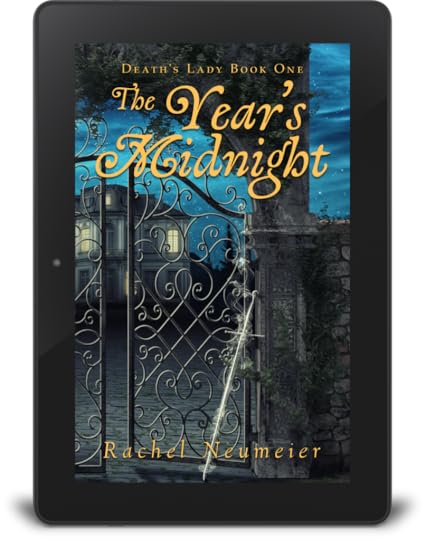
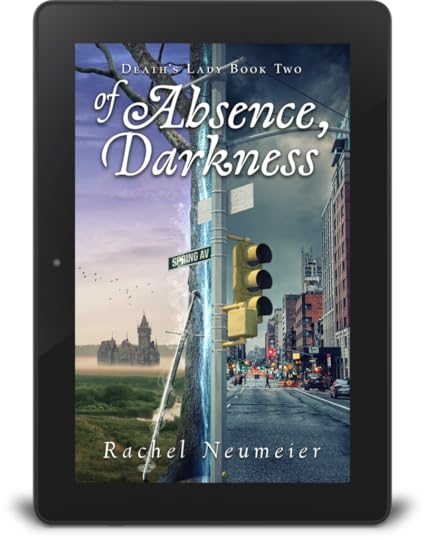
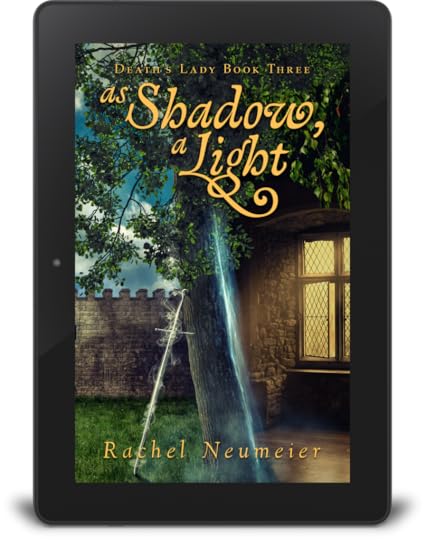
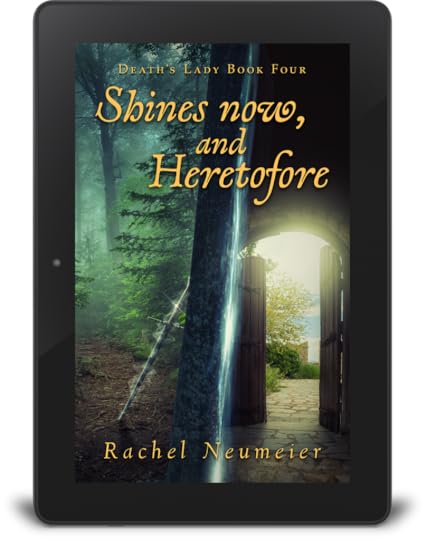
I haven’t thought a lot more about going on with this series, but I do really like it, and I do have fairly clear ideas and notes, so who knows? The original story contained in the trilogy was agonizingly difficult and took absolutely forever to write and then revise and revise and revise again. But Shines Now was easy and fast. If I contemplate that that smooth experience, I feel a bit more like moving ahead. Maybe later this year before I really get into Silver Circle, I’ll write a bit of another book in this series just to see how it feels.
Please Feel Free to Share:






The post Sale: Death’s Lady appeared first on Rachel Neumeier.



